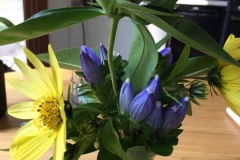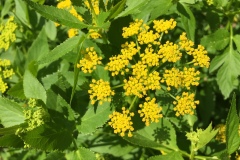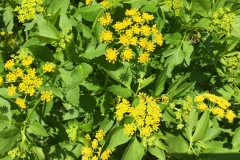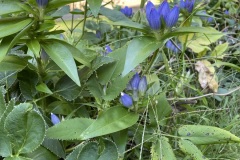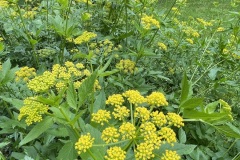One of the front pollinator beds was added in April 2020. At roughly 4′ x 15′, it contains twelve Golden Alexanders (host plants for black swallowtails and food source for a lot of the little solitary bees) and twelve Bottle Gentians, both from Prairie Nursery.
There’s a birdhouse at the western point, and a feeder at the other end along with some densely planted Disanthus cercidifolius, which is in the same family as witch hazel (Hamamelidaceae) and has stunning fall color. A group of three ‘lo gro’ aromatic sumacs gathers around the lowest branches of the immature Disanthus. (Disanthus is non-native and non-invasive. The rest are natives.) Crowded, but manageable with strategic pruning. The sumac is part of an ongoing effort to keep soil from moving down the front yard slope.
This was a pretty good plan, I thought, since the Alexanders are hosts to black swallowtails and provide great early pollinator support, blooming here from mid-May to mid-June. The Gentians provide late pollinator support from the second week in September all of the way to the third week in November, and the wine colored foliage of the disanthus looks amazing through that period:

(Insane color, right? Why aren’t these everywhere?)
The line between the Alexanders/Gentians is South/North so the view from the driveway is unobscured Alexanders in the spring followed by unobscured Gentians in the fall.
Too bad I didn’t consider the monotony of May to September in that bed:

Everything has its moment but there are still all those remaining moments. Birds do live and feed there, though, so that livens it up a bit.
Three pots of Echinacea ‘Magnus’ were added earlier this summer to provide a bridge from one time period to the next without quite so much downtime, but it’s been dry and while poor Magnus will survive he’s not looking happy about it.

The soil there is dense and poorly drained (if there is in fact rain) and the aspect is full sun. It lacks organic matter and the disanthus suffered from chlorosis the first year. After some heavy doses of compost and annual mulching I’m not seeing much that looks like nutritional deficiency this year.
Another thing I missed in planning was the lanky heights the Gentians and Alexanders can get to. They flop, so they could do with a late May chop by half, but that delays blooming and since they’re a gift to pollinators (the disanthus is the gift to *me*) that won’t be a good solution. Adding stakes this fall to support them better next year.
Gentians are pollinated by bumblebees, which are strong enough to force themselves into their weird little flowers. The thing is, bumblebees don’t seem to like to work that hard for their food anymore than anyone else, so they flock to the woodland sunflowers forty feet away. At least, that’s my theory. It’s also possible that they haven’t discovered them yet. It’s been several years, but bees have habits too. No bees here, because they’re being stubborn as I try to prove a point.

The good news they look great together as cut flowers, so it all works out!

Constant state of revision.

